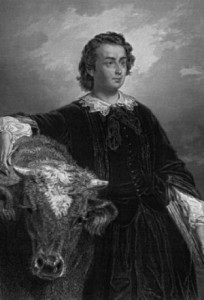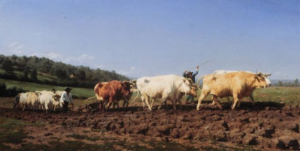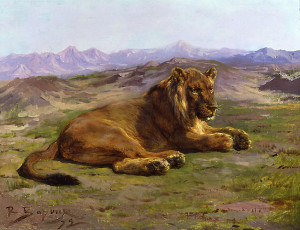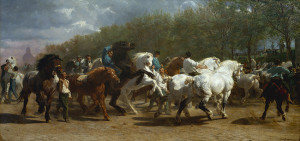
I did not find out about this badass until earlier this week. I should have known better than to stay ignorant for so long, because Rosa Bonheur is her own special kind of awesome.
She was raised in a socialist family that sought equality for the sexes, and she smoked cigars, cut her hair short, wore mens clothing (even gaining a permit from the police to do so), and it was rumored that she had lady lovers (why else would Art History Archive call Anna Klumpke her “special companion until her death”?). Most importantly, she was a world-renowned painter at a time when women were not regarded as artistic.
She was born in 1822 into a family of artists – her father was a trained artist and each of her four siblings had a vocation. Because training women in the arts was rare and unheard of in the 1800s, Rosa’s training was under her father as an apprentice in his shop. She copied engravings, drew still lifes, and copied paintings by masters in the Loeuvre. She also frequented “masculine” areas like horse fairs and slaughterhouses to study the anatomy of animals.
As a matter of fact, her subject of choice in her paintings were almost always animals, and she became famous for her animal paintings. She showed at the Paris Salon so many times the judges eventually gave her permission to just send her work in rather than go through the jury process.
Her most famous painting is Le Marché aux Chevaux, or “The Horse Fair,” show below:
When it was shown she was 31 years old.
She won quite a few gold medals for painting in the Salon, and also got the following honors over the course of her life:
- Honorary member of the Pennsylvania Academy of Fine Arts and the Société des Artistes Belges,
- Chevalier de la Légion d’Honneur (she was the first woman to get this award)
- The Cross of San Carlos of Mexico
- member of the Académie des Beaux-Arts of Antwerp, Belgium
- Commander’s Cross of the Royal Order of Isabella
- Catholic Cross
- The Leopold Cross
- honorary member of the Royal Academy of Watercolorists of London
- Mérite des Beaux-Arts de Saxe-Coburg-Gotha
- Officier de la Légion d’Honneur (the first woman honored with this position)
While her badassery was well-recognized, she eventually decided she didn’t like the spotlight and so she retired to the country side, drawing and painting until her death in 1899 at the age of 78. Many of her sketches and paintings were found posthumously by her aforementioned “special partner” Anna Klumpke.
If you want to find out more about this awesome painter, check out the Art History Archive, and books like Rosa Bonheur by Rosalia Shriver.
Thank you for reading, and I’ll see you on Monday.




Also worth noting: for a long time in her childhood, Rosa provided the sole means of support for her family through income earned by her paintings. Her father, as mentioned, was an artist as well, but work did not nearly garner as much acclaim as his daughter’s: thus, he lived vicariously through his daughter and took credit for several of her earl works.
This continued until a friend of the family interceded on Rosa’s behalf and had her move in with them and their daughter (who became Rosa’s first “lady love”). Rosa still have her money to her family to support them, but now she was the sole owner of her work :)
Oh my gosh that’s so cool!